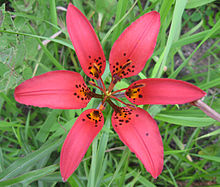Lilium philadelphicum
| Wood lily | |
|---|---|

| |
| Scientific classification | |
| Kingdom: | |
| (unranked): | |
| (unranked): | |
| Order: | |
| Family: | |
| Genus: | |
| Species: | L. philadelphicum
|
| Binomial name | |
| Lilium philadelphicum | |
| Synonyms[1] | |
| |
Lilium philadelphicum, also known as the wood lily, Philadelphia lily, prairie lily or western red lily, is a perennial species of lily native to North America.[2] It is widely distributed in much of Canada from British Columbia to Quebec, and parts of the United States (Northeast and Great Lakes regions plus the Rocky and Appalachian Mountains).[3][4]
Description
This lily grows to a height of approximately 30 to 90 centimeters, and produces red or orange blooms between June and August.[5]
A variant of the species, the western red lily (L. philadelphicum andinum) was designated Saskatchewan's floral emblem in 1941.[6][7] It is featured on the flag of Saskatchewan.
Conservation
The wood lily is listed as endangered in Maryland, New Mexico, Tennessee and North Carolina.[3][8] Its status is "threatened" in Kentucky and Ohio.[3]
In Saskatchewan, the flower is the provincial floral emblem[9] and is protected under the Provincial Emblems and Honours Act, meaning it cannot be picked, uprooted or destroyed in any way.[6]
Toxicity
Cats
Cats are extremely sensitive to lilly toxicity and ingenstion is often fatal.[10][11][12] Households and gardens that are visited by cats are strongly advised against keeping this plant or placing dried flowers where a cat may brush against them and become dusted with pollen that they then consume while cleaning.[13] Suspected cases require urgent veterinary attention.[14] Rapid treatment with activated charcoal and/or induced vomiting can reduce the amount of toxin absorbed (this is time-sensitive so in some cases vets may advise doing it at home), and large amounts of fluid by IV can reduce damage to kidneys to increase the chances of survival.[14]
References
- ^ Kew World Checklist of Selected Plant Families
- ^ Flora of North America Vol. 26 Page 180 Wood lily, lis de Philadelphie Lilium philadelphicum Linnaeus, Sp. Pl., ed. 2. 1: 435. 1762.
- ^ a b c "PLANTS Profile for lilium Philadelphicum". USDA. Retrieved 2008-07-09.
- ^ Biota of North America Program 2014 county distribution map
- ^ "Plant detail: Lilium philadelphicum". Evergreen. 2008. Retrieved 2008-07-09.
- ^ a b "Government House Gardens Showcase Western Red Lily". Government of Saskatchewan. 2005-07-21. Retrieved 2008-07-09.
- ^ "Saskatchewan's Provincial Flower". Government of Saskatchewan. Retrieved 2008-07-09.
- ^ "Endangered Plants of North Carolina". North Carolina Natural. February 2000. Retrieved 2008-07-09.
- ^ "Saskatchewan". Government of Canada. 2013-08-20. Retrieved 2015-07-18.
- ^ Frequently Asked Questions No Lillies For Cats.
- ^ Lily toxicity in the cat. Kevin T. Fitzgerald, PhD, DVM, DABVP.
- ^ Lilies Pet Poison Helpline.
- ^ The Valentine bouquet that killed my cats: Mother's Day warning on lethal lilies Daily Mail.
- ^ a b Lily Poisoning in Cats. Pet MD.
